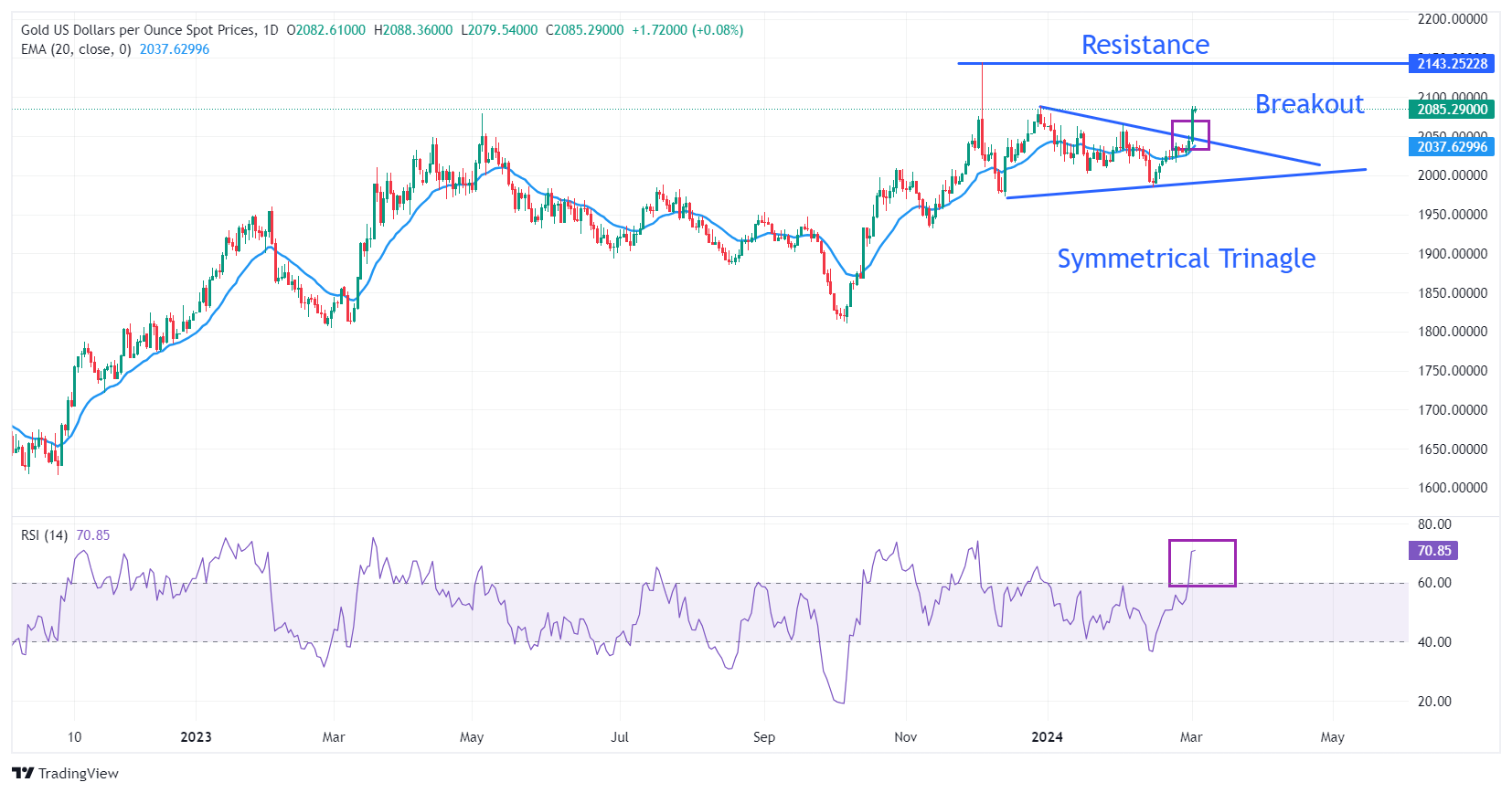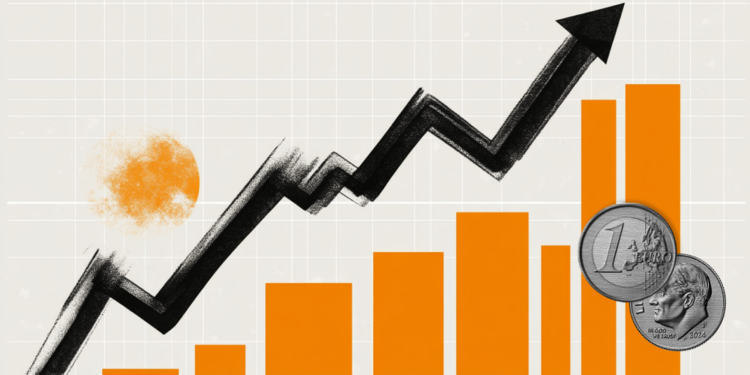- Gold prices near two-month highs as bets rise on a Fed rate cut in June.
- Weak US manufacturing PMI data weighs on the Dollar.
- Fed Chair Powell is likely to offer new data on the rate cut schedule this week.
The price of Gold (XAU/USD) hovered around two-month highs around $2,085 in the early stages of Monday's session in New York. The precious metal is holding on to gains amid growing expectations of an interest rate cut by the Federal Reserve (Fed) at its June policy meeting.
However, uncertainty over rate cut expectations could rebound this week as Fed Chair Jerome Powell will discuss inflation, interest rates and the economy in his appearance before Congress.
Jerome Powell is expected to maintain his hawkish stance as Fed policymakers want to see inflation ease for months before changing their monetary policy stance. Strong labor market conditions allow them to patiently monitor inflationary pressures and cut interest rates only when there is compelling evidence that inflation will fall to the desired 2% target.
Aside from the Fed's Powell comments, economic data such as the US Institute for Supply Management (ISM) services PMI, JOLTS job openings and Non-Farm Payrolls will continue to be the focus.
Meanwhile, the US Dollar Index (DXY), which measures the value of the greenback against six major currencies, falls to 103.80, as the manufacturing PMI surprisingly fell 1.3 points to 47.8 from 49.1 in January. Investors had expected a rise to 49.5. The manufacturing sector new orders index fell back into contraction territory, standing at 49.2 from 52.5 in January.
Daily summary of market movements: Gold remains strong, attention remains on US jobs data
- Gold price is trading near two-month highs around $2,085 as investors' expectations of Federal Reserve rate cuts at the June policy meeting remain firm. According to CME's FedWatch tool, traders see just over a 53% chance of a 25 basis point (bp) rate cut at the June meeting.
- Expectations for a rate cut in June remain high as January US personal consumption expenditure (PCE) price index data was in line with market consensus.
- This week, the strength of the Gold price will be tested by US ISM services PMI and labor market data for February, as well as Fed Chair Jerome Powell's testimony before Congress.
- The Fed chair will speak on Wednesday and Thursday. His outlook on interest rates could influence market expectations about the timing of rate cuts. Powell could reiterate the need for more evidence confirming that inflation will sustainably return to the 2% target.
- The strength of the labor market has accentuated uncertainty about the return of inflation to 2%. On Friday, Federal Reserve Governor Adriana Kugler said: “I am cautiously optimistic that we will see continued progress on disinflation without a significant deterioration in the labor market.”
- This week, US nonfarm payrolls (NFP) data will offer new insights into the labor market. Ahead of official labor market data, investors will focus on Automatic Data Processing (ADP) employment change data, due to be released on Wednesday. Expectations for new private payrolls stand at 150,000, up from the previous reading of 107,000.
- Meanwhile, the dollar fell sharply as the weak US ISM Manufacturing PMI for February suggests the strong US economy is releasing some heat. Looking ahead, the US ISM Services PMI, due out on Tuesday, will provide more insight into the economic outlook.
Gold price rebounds after an upward breakout of the Symmetrical Triangle pattern formed on a daily time frame. The breakout of the aforementioned chart pattern exhibits an expansion in volatility, resulting in broader upward ticks and high volume. The precious metal could extend its rise towards the horizontal resistance drawn from the December 4 high at $2,144.48.
The 20-day EMA is at $2,040, indicating strong short-term demand.
The 14-period Relative Strength Index (RSI) is above 60.00, indicating bullish momentum in the absence of divergence and oversold signals.
Frequently asked questions about Gold
Why invest in Gold?
Gold has played a key role in human history, as it has been widely used as a store of value and medium of exchange. Today, aside from its brilliance and use for jewelry, the precious metal is considered a safe-haven asset, meaning it is considered a good investment in turbulent times. Gold is also considered a hedge against inflation and against currency depreciation, since it is not dependent on any specific issuer or government.
Who buys more Gold?
Central banks are the largest holders of Gold. In their aim to support their currencies in turbulent times, central banks tend to diversify their reserves and purchase Gold to improve the perception of strength of the economy and currency. High Gold reserves can be a source of confidence for the solvency of a country. Central banks added 1,136 tons of gold worth about $70 billion to their reserves in 2022, according to data from the World Gold Council. This is the largest annual purchase since records exist. Central banks in emerging economies such as China, India and Turkey are rapidly increasing their gold reserves.
What correlation does Gold have with other assets?
Gold has an inverse correlation with the US Dollar and US Treasuries, which are the main reserve and safe haven assets. When the dollar depreciates, Gold tends to rise, allowing investors and central banks to diversify their assets in turbulent times. Gold is also inversely correlated with risk assets. A rally in the stock market tends to weaken the price of Gold, while sell-offs in riskier markets tend to favor the precious metal.
What does the price of Gold depend on?
The price can move due to a wide range of factors. Geopolitical instability or fear of a deep recession can cause the price of Gold to rise rapidly due to its status as a safe haven asset. Being a non-yielding asset, Gold tends to rise with lower interest rates, while the higher cost of money usually weighs on the yellow metal. However, most of the movements depend on the behavior of the US dollar (USD), as the asset is traded in dollars (XAU/USD). A strong dollar tends to keep the price of Gold in check, while a weaker dollar is likely to push up Gold prices.
Frequently asked questions about Gold
Why invest in Gold?
Gold has played a fundamental role in human history, as it has been widely used as a store of value and medium of exchange. Today, aside from its brilliance and use for jewelry, the precious metal is considered a safe-haven asset, meaning it is considered a good investment in turbulent times. Gold is also considered a hedge against inflation and currency depreciation, since it does not depend on any specific issuer or government.
Who buys more Gold?
Central banks are the largest holders of Gold. In their aim to support their currencies in turbulent times, central banks tend to diversify their reserves and purchase Gold to improve the perception of strength of the economy and currency. High Gold reserves can be a source of confidence for the solvency of a country. Central banks added 1,136 tons of gold worth about $70 billion to their reserves in 2022, according to data from the World Gold Council. This is the largest annual purchase since records exist. Central banks in emerging economies such as China, India and Turkey are rapidly increasing their gold reserves.
What correlation does Gold have with other assets?
Gold has an inverse correlation with the US Dollar and US Treasuries, which are the main reserve and safe haven assets. When the Dollar depreciates, the price of Gold tends to rise, allowing investors and central banks to diversify their assets in turbulent times. Gold is also inversely correlated with risk assets. A rally in the stock market tends to weaken the price of Gold, while sell-offs in riskier markets tend to favor the precious metal.
What does the price of Gold depend on?
The price of Gold can move due to a wide range of factors. Geopolitical instability or fear of a deep recession can cause the price of Gold to rise rapidly due to its status as a safe haven asset. As a non-yielding asset, the price of Gold tends to rise when interest rates fall, while rising money prices tend to weigh down the yellow metal. Still, most of the moves depend on how the US Dollar (USD) performs, as the asset is traded in dollars (XAU/USD). A strong Dollar tends to keep the price of Gold in check, while a weaker Dollar is likely to push up Gold prices.
Source: Fx Street
I am Joshua Winder, a senior-level journalist and editor at World Stock Market. I specialize in covering news related to the stock market and economic trends. With more than 8 years of experience in this field, I have become an expert in financial reporting.








